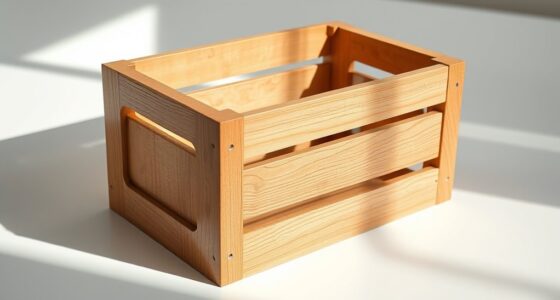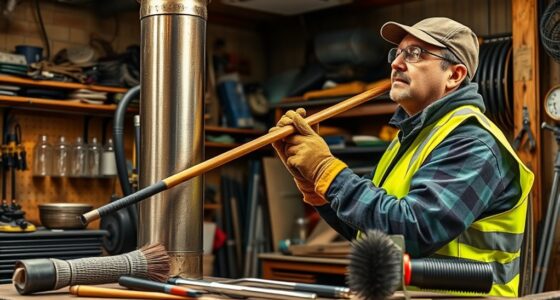To restore and reseason cast iron stove parts, start by thoroughly removing rust using a wire brush or vinegar solution, ensuring all rust is gone to create a smooth surface. Clean and dry the parts completely before applying a thin layer of high-smoke point oil like flaxseed or vegetable oil. Bake the parts at around 450°F for at least an hour, then repeat the process for a durable, non-stick coating. Continuing will reveal more tips for ideal results.
Key Takeaways
- Remove rust using wire brushes, steel wool, or vinegar solutions, then rinse and dry thoroughly.
- Ensure all rust is fully removed before proceeding to seasoning for optimal results.
- Apply a thin, even layer of high-smoke point oil to the cleaned parts before baking.
- Bake cast iron parts at 450°F for at least one hour, repeating oil application and baking as needed.
- Regularly clean and reseason to maintain a smooth, rust-resistant surface and prolong stove lifespan.

Restoring and reseasoning cast iron stove parts is a practical way to bring your stove back to life and guarantee it functions safely and efficiently. Over time, exposure to moisture and heat can cause rust to develop on cast iron, which not only affects its appearance but can also compromise its performance. To restore your stove, start with rust removal. You’ll want to remove any surface rust thoroughly, using a wire brush, steel wool, or abrasive pad. For stubborn rust, soaking parts in a vinegar solution can help loosen corrosion. Be gentle but persistent, making certain you don’t damage the cast iron’s surface. Once the rust is gone, rinse the parts with water and dry them completely to prevent new rust from forming. Proper rust removal techniques are essential to ensure your cast iron is clean and ready for reseasoning.
After cleaning, it’s vital to prepare the surface for seasoning. Proper seasoning techniques create a protective layer that prevents future rust and enhances the non-stick qualities of your cast iron. Apply a thin coat of high-smoke point oil, such as flaxseed or vegetable oil, using a clean cloth or paper towel. Make sure to cover every nook and cranny evenly. Then, bake the parts in an oven at around 450°F (232°C) for at least an hour. This heat allows the oil to polymerize, forming a durable, non-stick coating. Repeating the oil application and baking process multiple times can build up a more effective protective layer, especially if the surface is new or heavily rusted. The key is to build up a smooth, seasoned surface that protects the cast iron while providing better heat distribution. Regular maintenance and proper ventilation considerations can also extend the lifespan of your stove parts, as good airflow helps prevent moisture buildup and rust formation. Additionally, understanding how sound vibrations can influence the healing process is interesting, as proper airflow can help maintain optimal conditions for seasoning and prevent moisture-induced corrosion. Ensuring proper airflow around your stove is also vital for safe operation and effective heat circulation.
Frequently Asked Questions
Can I Restore Cast Iron Stove Parts Without Professional Help?
Yes, you can do a DIY restoration of cast iron stove parts, but it requires careful cleaning, removing rust, and reseasoning. Follow proper steps like scrubbing with a wire brush, applying vegetable oil, and baking it to create a protective coating. However, if your parts are severely damaged or corroded, it’s better to seek professional repair to ensure safety and longevity. Always assess your skill level before attempting complex restoration.
How Long Does Reseasoning Cast Iron Stove Parts Typically Last?
Think of your cast iron stove parts like a well-loved book; the seasoning can last months or even years with proper care. Typically, seasoning longevity depends on maintenance frequency—regular cleaning and avoiding harsh chemicals extend it. If you reseason annually or when needed, your stove stays protected and functional. Proper upkeep keeps your stove in prime condition, ensuring that the seasoning’s protective layer endures through seasons of use.
Are There Specific Cleaning Products Recommended for Cast Iron Stove Parts?
You should use specialized cleaning agents designed for cast iron stove parts to prevent damage and maintain seasoning. Avoid harsh chemicals that can strip the seasoning layer. Instead, consider natural remedies like baking soda paste or coarse salt with a damp cloth for gentle cleaning. These methods effectively remove debris without harming the cast iron, helping you keep your stove in top condition and ready for reseasoning when needed.
What Are Common Signs That Stove Parts Need Reseasoning or Restoration?
You’ll notice seasoning wear when the surface looks dull, flaky, or uneven, indicating it needs reseasoning. Rust formation also signals that restoration is necessary, especially if you see reddish-brown spots or rough patches. If your stove parts no longer shine or develop rust, it’s time to clean, strip, and reseason to restore their protective coating and keep your cast iron in top shape.
Can Damaged Cast Iron Stove Parts Be Repaired or Only Replaced?
Imagine a cast iron stove part with a deep crack that threatens its integrity. In many cases, you can perform cast iron repair by welding or brazing to restore strength. However, if the damage is extensive or the part is severely warped, stove part replacement becomes the better option. Carefully evaluate the damage to decide whether repair or replacement suits your needs best, ensuring safe and efficient stove operation.
Conclusion
Just like a master blacksmith restoring ancient armor, your effort in restoring and reseasoning your cast iron stove parts breathes new life into old craftsmanship. With patience and care, you transform rusty relics into shining symbols of resilience and warmth. Remember, every seasoned piece carries the legacy of generations past—your dedication guarantees it continues to serve and inspire for years to come. Embrace the process, and let your stove become a timeless hearth in your home’s story.










